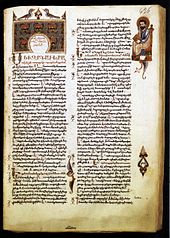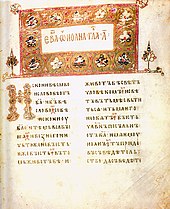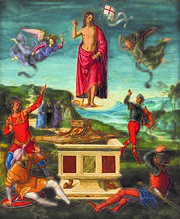Jesus in Christianity
[7] According to the gospel accounts, Jesus was born of a virgin, and he taught other Jews how to follow God (sometimes using parables), performed miracles and gathered disciples.
[8][9][10] Christian views of Jesus are derived from various biblical sources, particularly from the canonical gospels and New Testament letters such as the Paul epistles.
[14] The five major milestones in the gospel narrative of the life of Jesus are his baptism, transfiguration, death by crucifixion, resurrection and ascension to Heaven.
[15][17] The gospel accounts of the teachings of Jesus are often presented in terms of specific categories involving his "works and words", e.g., his ministry, parables and miracles.
[21] Christians predominantly profess that through Jesus' life, death, and rising from the dead, he restored humanity's right relationship with God with the blood of the New Covenant.
"[32] λόγος in the original Koine Greek is translated as Word and in theological discourse, this is often left in its English transliterated form, Logos.
One of the relevant New Testament passages is John 1:1-18 where, in the Trinitarian view, Christ is identified with a pre-existent divine hypostasis called the Logos or Word.
Following the Apostolic Age, from the 2nd century forward, several controversies developed about how the human and divine are related within the person of Jesus.
Unlike Adam, the new man born in Jesus obeys God and ushers in a world of morality and salvation.
[25]In the canonical gospels, the Ministry of Jesus begins with his baptism in the countryside of Judea, near the River Jordan and ends in Jerusalem, following the Last Supper.
[65][66][67][68] Jesus' early Galilean ministry begins when after his baptism, he goes back to Galilee from his time in the Judean desert.
[75][76][77][78] As Jesus travels towards Jerusalem, in the later Perean ministry, about one third the way down from the Sea of Galilee along the River Jordan, he returns to the area where he was baptized.
[82] The gospels provide more details about the final ministry than the other periods, devoting about one third of their text to the last week of the life of Jesus in Jerusalem.
[92] The five discourses in Matthew begin with the Sermon on the Mount, which encapsulates many of the moral teachings of Jesus and which is one of the best known and most quoted elements of the New Testament.
[89][93] The Sermon on the Mount includes the Beatitudes which describe the character of the people of the Kingdom of God, expressed as "blessings".
[94] The Beatitudes focus on love and humility rather than force and exaction and echo the key ideals of Jesus' teachings on spirituality and compassion.
He suggests that Jesus did not form his parables merely as analogies but based on an "inward affinity between the natural and the spiritual order.
This was for the people of Israel not to understand and realize who Jesus is and accept him, he purposely did this to make provision for Gentiles[106] to be part of the children of God.
[115][116][117] Christian authors also view the miracles of Jesus not merely as acts of power and omnipotence, but as works of love and mercy: they were performed to show compassion for sinful and suffering humanity.
[114] Authors Ken and Jim Stocker state that "every single miracle Jesus performed was an act of love".
[114] The accounts of the crucifixion and subsequent resurrection of Jesus provide a rich background for Christological analysis, from the canonical gospels to the Pauline epistles.
[125][126] Further reinforcement of the concept is provided in Revelation 21:14, where the "lamb slain but standing" is the only one worthy of handling the scroll (i.e., the book) containing the names of those who are to be saved.
[127] A central element in the Christology presented in the Acts of the Apostles is the affirmation of the belief that the death of Jesus by crucifixion happened "with the foreknowledge of God, according to a definite plan".
For Paul, Jesus' crucifixion is directly related to his resurrection and the term "the cross of Christ" used in Galatians 6:12 may be viewed as his abbreviation of the message of the gospels.
[130] In the Pauline view, Jesus, obedient to the point of death (Philippians 2:8), died "at the right time" (Romans 4:25) based on the plan of God.
In the Eastern Church Sergei Bulgakov argued that the Crucifixion of Jesus was "pre-eternally" determined by the Father before the creation of the world, to redeem humanity from the disgrace caused by the fall of Adam.
[139] Paul explained the importance of the resurrection of Jesus as the cause and basis of the hope of Christians to share a similar experience in 1 Cor 15:20–22:
[144] The Apostolic Fathers, discussed the death and resurrection of Jesus, including Ignatius (50−115),[145] Polycarp (69−155), and Justin Martyr (100−165).
[146] Following the conversion of Constantine and the liberating Edict of Milan in 313, the ecumenical councils of the 4th, 5th and 6th centuries, that focused on Christology helped shape the Christian understanding of the redemptive nature of resurrection, and influenced both the development of its iconography, and its use within liturgy.
[148][149] Nontrinitarian Christian groups include the Church of Jesus Christ of Latter-day Saints,[150] Unitarians and Jehovah's Witnesses.








